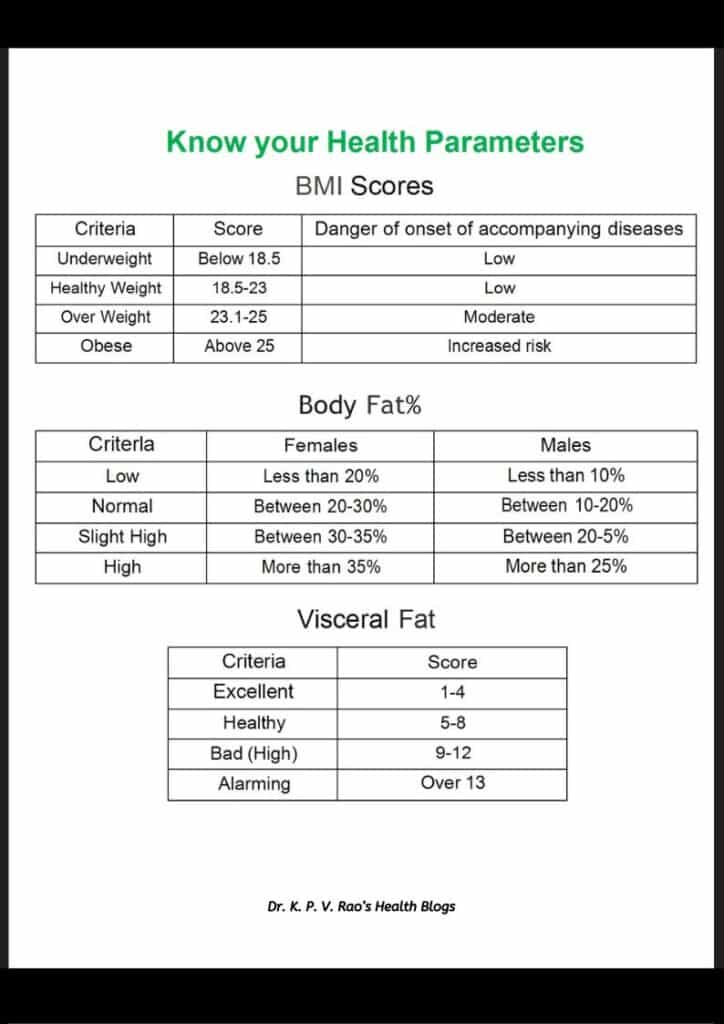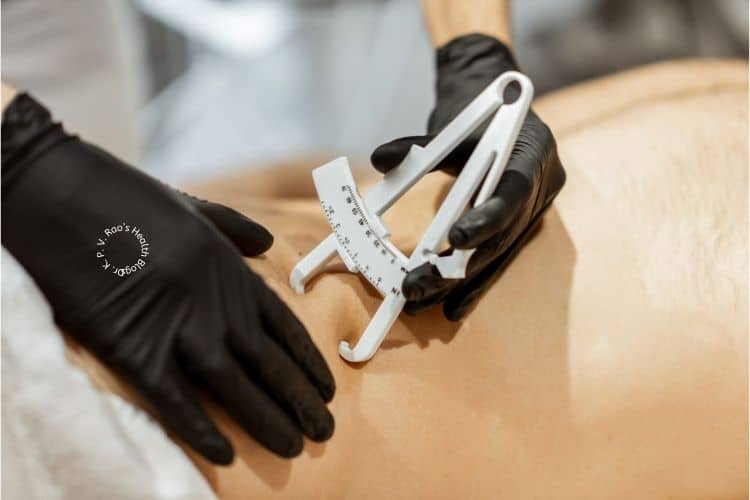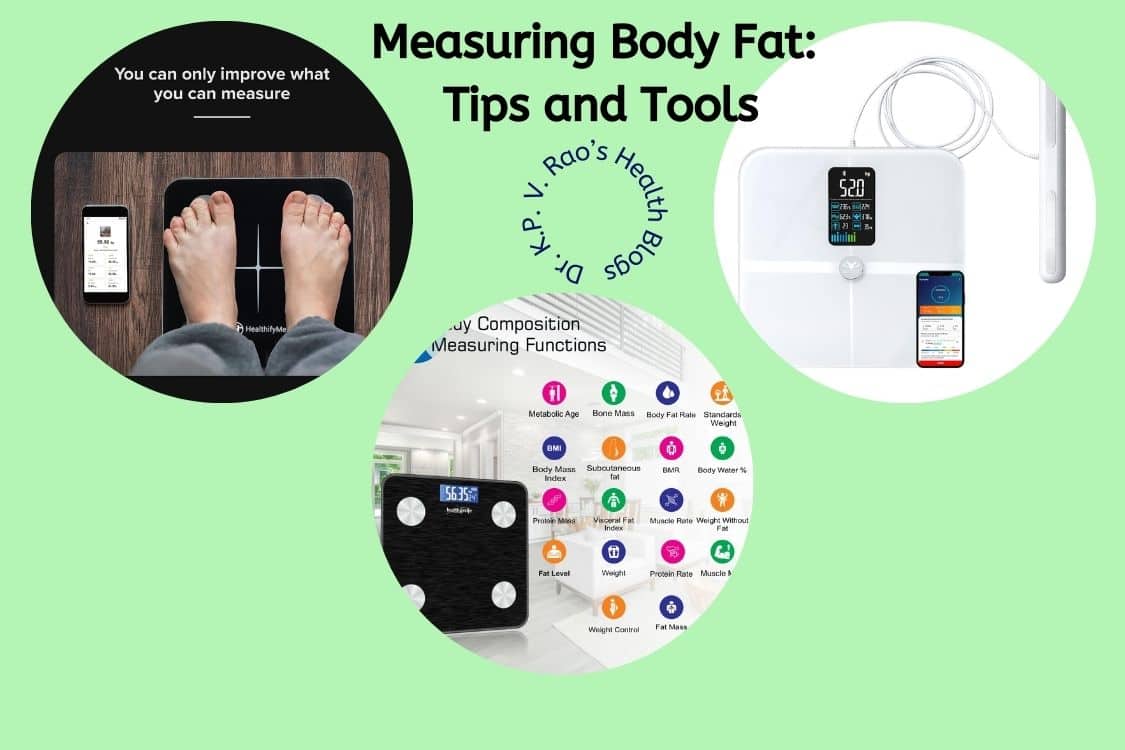Table of Contents
What is Body Fat?
Are you tired of stepping on the scale and not getting the full picture of your body’s composition? If so, it’s time to dive into the world of measuring body fat accurately.
Body Fat concerns are growing by the day as a epidemic of overweightness and obesity is sweeping the globe, bringing with it ailments like heart disease, diabetes, arthritis, etc., to name a few.
In this ultimate guide, I will equip you with the knowledge and tools necessary to get a precise understanding of your body fat percentage. Before we do that, let’s first learn the different types of fats we come across in our body.
Types of Body fats and their purpose
You will find many categories of body fats that serve different purposes, depending on their location. Most of the body fat is stored in body tissue called adipose tissue.
Here is a picture followed by a list of the various types of body fats and the purpose they serve in our body-

- White adipose tissue: Energy storage and insulation.
- Brown adipose tissue: Heat production. Mostly found in areas such above the clavicle in the chest and by the side of vertebral column. In animals, it is referred to as ” blubber”.
- Subcutaneous fat: Protects organs and stores energy.
- Visceral fat: Surrounds internal organs for protection.
- Intramuscular fat: Provides energy for muscle contractions.
- Epicardial fat: Cushions the heart and regulates heart function.
- Pericardial fat: Helps insulate the heart and maintain temperature.
- Mesenteric fat: Supports and protects abdominal organs.
- Peri-renal fat: Cushions the kidneys and maintains their position.
- Bone marrow fat: Stores energy and regulates bone metabolism.
Why is measuring body fat important?
Knowing your body fat percentage is essential for various reasons, from tracking progress on your fitness journey to assessing your overall health. While the number on the common scale can give you a general idea of your weight, it fails to differentiate between fat, muscle, and other body tissues.
Measuring body fat allows you to have a more accurate picture of your body composition, helping you make informed decisions about your health and fitness goals.
Body fat percentage is particularly crucial for athletes and fitness enthusiasts who want to monitor their progress and make adjustments to their training and nutrition plans.
It can also be an important indicator of health risks, as excessive body fat has been linked to various health conditions such as heart disease, diabetes, and certain types of cancer. Before we dig into different parameters of our body composition, let’s have a look at the normal values-

Understanding body fat percentages
Before diving into the various tools and methods for measuring body fat, it’s important to understand the different ranges of body fat percentages and what they mean for your health and fitness goals.
I have already mentioned what are the different types of fats available in our body areawise and the purpose they serve. Now we will learn what should be the normal values of total fats in various categories of individuals in the table below:
| Category | Body Fat Percentage Range |
|---|---|
| Healthy Male | 10-20% |
| Healthy Female | 20-30% |
| Healthy Male Athlete | 6-13% |
| Healthy Female Athlete | 14-20% |
The following breakdown represents the percentages of different types of fats found in the overall body fat mentioned above-
- Visceral fat: 10-20%
- Subcutaneous fat: 20-30%
- Intramuscular fat: 1-5%
- Brown fat: 1-2%
- White fat: 20-30%
It’s important to note that these ranges can vary depending on age, genetics, and individual goals.
Body fat percentages above the recommended ranges can increase the risk of health issues, while excessively low percentages can also have negative impacts on health and performance.
Different methods of measuring body fat
There are several methods available for measuring body fat, each with its own advantages and limitations. Let’s explore some of the most commonly used methods:
1. Skinfold calipers
Skinfold calipers are one of the most accessible and affordable methods for measuring body fat. This technique involves using calipers to measure the thickness of skinfolds at specific sites on the body. The measurements are then plugged into an equation to estimate body fat percentage.
To ensure accuracy, it’s important to follow proper measurement techniques and have an experienced professional perform the measurements. Skinfold calipers are particularly useful for tracking changes in body fat over time, making them a popular choice among athletes and fitness enthusiasts.
However, it’s worth noting that skinfold calipers have a margin of error, and results can vary depending on the skill of the person performing the measurements. Additionally, this method may not be suitable for individuals with excessive amounts of loose skin or very low body fat percentages.
2. Bioelectrical impedance analysis (BIA)
Bioelectrical impedance analysis (BIA) is a method that measures body fat by sending a low electrical current through the body. The resistance encountered by the current is used to estimate body fat percentage. BIA can be performed using handheld devices or scales equipped with BIA technology.
One of the main advantages of BIA is its ease of use and non-invasiveness. It can be performed at home using handheld devices, making it convenient for regular monitoring. However, BIA measurements can be affected by factors such as hydration levels, temperature, and body position, which can introduce some degree of error.
3. Body mass index (BMI)
While not a direct measure, the body mass index (BMI) is often used as an indicator of whether an individual is underweight, normal weight, overweight, or obese. BMI is calculated by dividing a person’s weight in kilograms by their height in meters squared.
While BMI can provide a rough estimate of body fat levels, it has limitations. For example, it does not take into account variations in body composition or distribution of fat. Individuals with high muscle mass may have a higher BMI, despite having a low body fat percentage.
4. Dual-energy X-ray absorptiometry (DEXA)
Dual-energy X-ray absorptiometry (DEXA) is considered one of the most accurate methods for measuring body fat. It uses X-rays to differentiate between fat, muscle, and bone mass. DEXA scans provide detailed information about body composition, including regional fat distribution.
DEXA scans are commonly used in research settings and by healthcare professionals. They can provide accurate measurements of body fat percentage with minimal margin of error. However, DEXA scans may not be easily accessible or affordable for everyone.
5. Smart Scales

Smart scales are the latest advanced devices that can measure various aspects of body composition, including body fat percentage. These scales use bioelectrical impedance analysis (BIA) to estimate body fat based on the flow of a weak electrical current through the body.
By sending this current, the scales can measure the resistance encountered by the current, which provides a rough estimate of body fat percentage. The results calculated by this machine can easily be shared on your smart phone using bluetooth.
I personally use one at home to keep a track of my health.
Tools for measuring body fat at home
If you prefer to measure your body fat in the comfort of your own home, there are various tools available that can provide reasonably accurate estimates. Here are some popular options:
1. How to use Digital Smart scales
Digital body fat scales use BIA technology to estimate body fat percentage. These scales send a small electrical current through your body and analyze the resistance encountered. They can provide quick and convenient measurements, but accuracy may vary depending on the quality of the scale.
When using digital smart scales, it’s important to follow the instructions carefully, ensuring proper hydration levels and a consistent testing environment. While these scales can be a useful tool for tracking changes in body fat over time, they may not provide the same level of accuracy as more specialized methods.
2. How to use Online body fat calculators
Online body fat calculators can provide estimates based on various formulas and measurements. These calculators typically require input such as height, weight, gender, and sometimes additional measurements like waist circumference or hip circumference.
While online calculators can be a quick and accessible option, they are generally less accurate than other methods. However, there is no harm in getting a approximate value. Try it by putting in some of your personal data below:
The calculations are based on generalized equations, which may not take into account individual variations in body composition like your build [short, tall, shoulder-broad, average or small], underweight, overweight or obese.
3.How to measure body fat accurately using skinfold calipers
If you’re looking for a more hands-on approach, skinfold calipers can be a great option.

Here is a step-by-step guide on how to use skinfold calipers accurately:
Choose the appropriate sites for measurement: Skinfold calipers are typically used to measure specific sites on the body, such as the triceps, biceps, subscapular, and suprailiac region. These sites are chosen based on the accuracy of the measurements and ease of access.
- Prepare the measurement area: Before taking the measurements, ensure that the skin is clean, dry, and free from lotions or oils. This will help ensure accurate readings.
- Grasp the skinfold: Use your thumb and forefinger to grasp the skinfold at the chosen site. Be careful not to include any underlying muscle tissue.
- Take the measurement: Apply the calipers perpendicular to the skinfold, approximately 1 cm away from your fingers. Release the calipers slowly, allowing them to measure the skinfold thickness. Take the measurement in millimeters.
- Repeat the process: Take multiple measurements at each site to ensure consistency and accuracy. Ideally, three measurements should be taken, and the average should be calculated.
- Calculate body fat percentage: Once you have the measurements, you can use a specific equation to estimate body fat percentage.
- There are different equations available depending on the sites measured and the gender of the individual. Consult with a professional or use an online calculator to determine the most appropriate equation for your measurements.
Use this link if you are interested in purchasing one: https://amzn.eu/d/6OK823K
It’s important to note that the accuracy of skinfold caliper measurements can vary depending on the skill of the person performing the measurements. For a quick calculation, put in your skinfold caliper in this app below:
For the most accurate results, it’s recommended to have an experienced professional perform the measurements.
You can refer to this article for an in-depth study about using skinfold calipers:
How to Use Skinfold Calipers to Measure Body Fat Percentage
4.How to use Handheld BIA devices
Handheld BIA devices work similarly to digital smart scales but in a more compact and portable form.
These devices are usually held with both hands, and a small electrical current is passed through the body. The resistance encountered is used to estimate body fat percentage.
Handheld BIA devices are convenient for regular monitoring and can be easily used at home. However, as with digital smart scales, accuracy can vary depending on the quality of the device and proper usage.
The benefits and limitations of bioelectrical impedance analysis (BIA)
Bioelectrical impedance analysis (BIA) is a popular method for measuring body fat due to its ease of use and convenience. Here are some of the benefits and limitations of using BIA:
Benefits of BIA:
- Non-invasiveness: BIA is a non-invasive method that does not require any needles or special procedures.
- Convenience: BIA can be performed at home using handheld devices or scales equipped with BIA technology, making it a convenient option for regular monitoring.
- Affordability: BIA devices are relatively affordable and accessible to the general public.
Limitations of BIA:
- Variability: BIA measurements can be affected by factors such as hydration levels, temperature, and body position, which can introduce some degree of error.
- Accuracy: While BIA can provide estimates of body fat percentage, the accuracy may vary depending on the quality of the device and proper usage.
- Not suitable for everyone: BIA may not be suitable for individuals with certain medical conditions, such as those with pacemakers or other implanted medical devices.
Despite its limitations, BIA can still be a valuable tool for tracking changes in body fat over time, especially when used consistently and under controlled conditions.
The role of DEXA scans in accurate body fat measurement
When it comes to accuracy, dual-energy X-ray absorptiometry (DEXA) scans are considered one of the most precise methods for measuring body fat. Here’s why DEXA scans are highly regarded:
- Accurate body composition analysis: DEXA scans provide detailed information about body composition, including fat, muscle, and bone mass. This can be useful for athletes, individuals with specific health conditions, and those looking for precise measurements.
- Regional fat distribution: DEXA scans can identify fat distribution in different regions of the body, such as the trunk, arms, and legs. This information can be valuable for assessing health risks associated with certain fat distribution patterns.
- Research and clinical use: DEXA scans are commonly used in research settings and by healthcare professionals to assess body composition and monitor changes over time.
It’s worth noting that DEXA scans may not be easily accessible or affordable for everyone. They are typically performed in specialized clinics or research centers. However, if you have specific health concerns or require precise measurements for your fitness goals, a DEXA scan can provide valuable insights.
Disclosure
This article contains affiliate links to Amazon, meaning, if you, reader, makes a purchase using the link, this site receives a small commission that helps to maintain this website, without any extra charge to the purchaser.
Conclusion: Choosing the right method for measuring body fat
Remember, body fat measurement and management are just one piece of puzzle. You should focus on overall health, wellbeing and sustainable lifestyle habits rather than solely fixating on a specific number.
Accurately measuring body fat is essential for tracking progress, setting goals, and assessing overall health. There are various methods and tools available, each with its own benefits and limitations.
From skinfold calipers and bioelectrical impedance analysis (BIA) to the body mass index (BMI) and DEXA scans, each method offers unique insights into body composition. The choice of method ultimately depends on your goals, budget, and accessibility.
Remember to establish a baseline, track consistently, and consider other indicators of progress. Body fat measurements should be used as part of a holistic approach to health and fitness.
Now, say goodbye to guesswork and hello to accurate body fat measurements. Take control of your health and fitness goals by learning how to measure your body fat correctly.
With the knowledge and tools provided in this ultimate guide, you’ll be equipped to make informed decisions and stay on track to achieve your desired body composition.
Here are some articles I have posted that relate to body fats:
Final Words
Hope I have made it easy for you to calculate your body fat accurately and also the tips to maintain it. If you have found this article useful, do share it on the social media icons at the bottom of this article. You can also Click to Tweet here-
The Ultimate Guide to Accurately Measuring Body Fat: Tips and Tools Share on XHaving understood how to know your body fat percentage, we will now learn how to use a Smart Scale in my next article. Do remain connected.
You can easily keep a track of my articles by downloading a Flipboard app on your smartphone phone. Click here to connect- Flipboard.




![How to Match Your Biological and Your Chronological Age [Ultimate Guide] 15 Biological age vs chronological age](https://raodoctor.com/wp-content/uploads/2022/12/Add-a-subheading-11-300x300.jpg)
